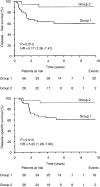Cysteine proteinase inhibitor cystatin C in squamous cell carcinoma of the head and neck: relation to prognosis
- PMID: 15138478
- PMCID: PMC2409457
- DOI: 10.1038/sj.bjc.6601830
Cysteine proteinase inhibitor cystatin C in squamous cell carcinoma of the head and neck: relation to prognosis
Abstract
To determine the role of the cysteine proteinase inhibitor cystatin C in the invasive behavior of squamous cell carcinoma of the head and neck (SCCHN), Cystatin C protein level was measured in 82 pairs of primary tumour tissue and adjacent noncancerous mucosa, using the enzyme-linked immunosorbent assay. The median level of cystatin C in tumour tissue was 1.18 times lower than that in corresponding mucosa (P=0.031). In normal mucosa samples, the cystatin C level was influenced by the site of sampling: it was lower in nonlaryngeal tissue samples (oral cavity, oro- or hypopharynx) than in laryngeal samples (P=0.004). The tumour cystatin C level correlated inversely with pN-stage (P=0.047), whereas a trend of lower cystatin C levels was observed in the group with extranodal tumour extension compared to those with no extranodal spread (P=0.069). In univariate analysis, the patients with low tumour cystatin C levels exhibited poor disease-free survival (DFS, P=0.013) and disease-specific survival (DSS, P=0.013). In multivariate analysis, the most powerful predictor of survival was pN-stage (DFS: P=0.040, HR 2.78; DSS: P=0.011, HR 4.36,), followed by the cystatin C level (DFS: P=0.043, HR 0.22; DSS: P=0.067, HR 0.25). When comparing the prognostic strength of cystatin C to that of stefin A, another cysteine proteinase inhibitor, which emerged as the most significant prognosticator for survival in our previous study analysing the same cohort of patients, stefin A proved to be significantly more reliable predictor for both DFS and DSS than cystatin C. Our results indicate that cystatin C is implicated in the invasive behavior of SCCHN, and that there are variations in regulation of proteolytic pathways under nonmalignant conditions, inherent to individual subsites inside the upper aerodigestive tract. The correlation between high cystatin C levels and improved survival concurs with the concept of the protective role of high levels of cysteine proteinase inhibitors in tissue homogenates that has been previously suggested by the survival results in breast and lung carcinoma as well as SCCHN.
Figures


Similar articles
-
Prognostic significance of cysteine proteinases cathepsins B and L and their endogenous inhibitors stefins A and B in patients with squamous cell carcinoma of the head and neck.Clin Cancer Res. 2000 Mar;6(3):1052-62. Clin Cancer Res. 2000. PMID: 10741734
-
Cysteine proteinase inhibitors stefin A, stefin B, and cystatin C in sera from patients with colorectal cancer: relation to prognosis.Clin Cancer Res. 2000 Feb;6(2):505-11. Clin Cancer Res. 2000. PMID: 10690531
-
Prognostic value of cathepsins B, H, L, D and their endogenous inhibitors stefins A and B in head and neck carcinoma.Biol Chem Hoppe Seyler. 1996 Jun;377(6):385-90. doi: 10.1515/bchm3.1996.377.6.385. Biol Chem Hoppe Seyler. 1996. PMID: 8839984 Clinical Trial.
-
[Stefin A--potential application in oncological laboratory diagnosis].Pol Merkur Lekarski. 2005 Jul;19(109):86-9. Pol Merkur Lekarski. 2005. PMID: 16194036 Review. Polish.
-
Role of cystatin C in urogenital malignancy.Front Endocrinol (Lausanne). 2022 Dec 14;13:1082871. doi: 10.3389/fendo.2022.1082871. eCollection 2022. Front Endocrinol (Lausanne). 2022. PMID: 36589819 Free PMC article. Review.
Cited by
-
A molecular index for biological age identified from the metabolome and senescence-associated secretome in humans.Aging Cell. 2024 Apr;23(4):e14104. doi: 10.1111/acel.14104. Epub 2024 Mar 7. Aging Cell. 2024. PMID: 38454639 Free PMC article.
-
Cathepsin L inhibition by the small molecule KGP94 suppresses tumor microenvironment enhanced metastasis associated cell functions of prostate and breast cancer cells.Clin Exp Metastasis. 2013 Oct;30(7):891-902. doi: 10.1007/s10585-013-9590-9. Epub 2013 Jun 9. Clin Exp Metastasis. 2013. PMID: 23748470 Free PMC article.
-
Development of a Prognostic Score for Cholangiocarcinoma Patients Using a Combination of Biochemical Parameters.In Vivo. 2023 May-Jun;37(3):1145-1155. doi: 10.21873/invivo.13189. In Vivo. 2023. PMID: 37103102 Free PMC article.
-
Cystatin C deficiency suppresses tumor growth in a breast cancer model through decreased proliferation of tumor cells.Oncotarget. 2017 Apr 24;8(43):73793-73809. doi: 10.18632/oncotarget.17379. eCollection 2017 Sep 26. Oncotarget. 2017. PMID: 29088746 Free PMC article.
-
Prognostic significance of serum cystatin C in multiple myeloma.Int J Hematol. 2012 May;95(5):545-50. doi: 10.1007/s12185-012-1049-2. Epub 2012 Mar 18. Int J Hematol. 2012. PMID: 22426688
References
-
- Abel U, Berger J, Wiebelt H (1984) Critlevel: an exploratory procedure for the evaluation of quantitative prognostic factors. Methods Inform Med 23: 154–156 - PubMed
-
- Azzopardi JG, Chepizk OF, Hartman WH (1981) International Histological Classification of Tumours No 2: Histological Typing of Breast Tumours. Geneva: World Health Organization
-
- Bradford MM (1976) A rapid and sensitive method for the quantification of microgram quantities of protein utilizing the principle of protein–dye binding. Anal Biochem 72: 248–254 - PubMed
-
- Chapman HA, Riese RJ, Shi GP (1997) Emerging roles for cysteine proteinases in human biology. Annu Rev Physiol 59: 63–88 - PubMed
Publication types
MeSH terms
Substances
LinkOut - more resources
Full Text Sources
Other Literature Sources
Medical
Research Materials
Miscellaneous

